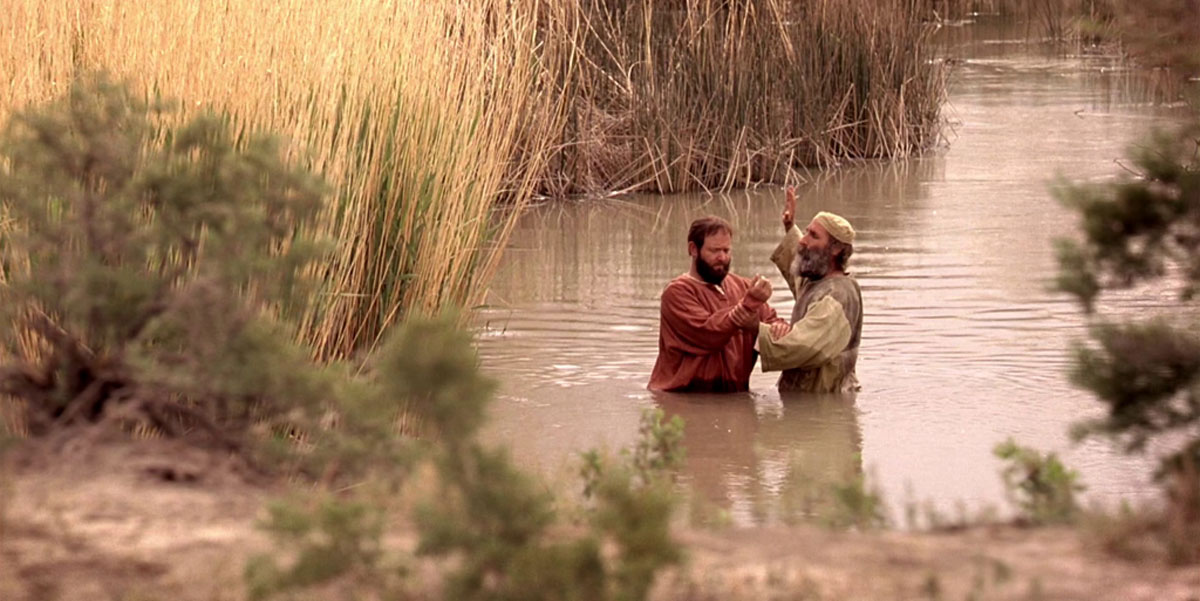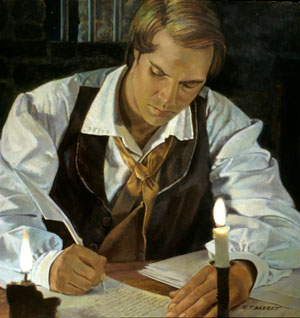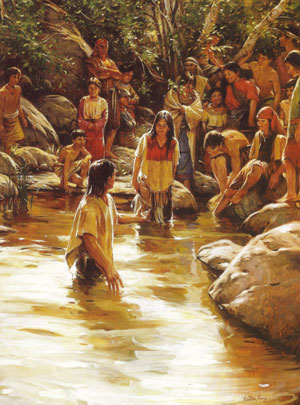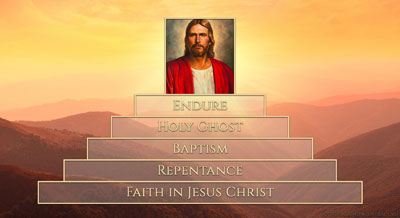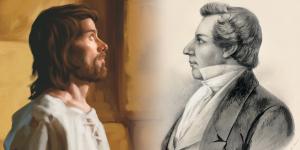You are here
Where Does the Book of Mormon Declare the First Principles and Ordinances of the Gospel?

3 Nephi 27:20
The Know
On March 1, 1842, the Church newspaper Times and Seasons published a letter that Joseph Smith had written to a Chicago newspaper reporter named John Wentworth.1 In this letter, Joseph wrote a list of statements about LDS doctrine that would later become the Articles of Faith,2 including the familiar declaration of “the first principles and ordinances of the Gospel” as faith, repentance, baptism, and receiving the Holy Ghost (Articles of Faith 1:4). Many Latter-day Saints may be unaware that Joseph Smith probably learned of this four-step pattern from the Book of Mormon.3
Although the Doctrine and Covenants talks about the first principles and ordinances of the gospel, it is likely that the Book of Mormon was the first place Joseph Smith saw this doctrine laid out in a systematic way.4 Doctrine and Covenants 20:8–9, revealed sometime after April 1830, affirms that the Book of Mormon (published in March 1830) contains “the fulness of the gospel of Jesus Christ,” and that the Book of Mormon lays out the principles that constitute this “fulness of the gospel.”5 These principles are exactly the same principles found in the fourth Article of Faith: faith in Jesus Christ, repentance, baptism, receiving the gift of the Holy Ghost, and enduring to the end.6
Joseph may well have first encountered this formulation as he translated the words of Christ Himself, as delivered in 3 Nephi. In 3 Nephi 27, Christ defines His gospel stating that no one could enter into His rest except those who had washed “their garments in my blood, because of their faith ... Now this is the commandment: Repent, all ye ends of the earth, and come unto me and be baptized in my name, that ye may be sanctified by the reception of the Holy Ghost . . . Verily, I say unto you, this is my gospel.” (3 Nephi 27:19–21, emphasis added).7
Verses like this show that the Book of Mormon is one of the best sources for clearly understanding the first principles and ordinances of the gospel. Noel B. Reynolds explained that, in the Book of Mormon, God promised His children salvation through “faith on his Son, repentance and baptism, receiving the remission of sins through the baptism of fire and of the Holy Ghost, and by enduring in faith, hope, and charity to the end of mortal life. This central teaching gave coherence and foundation to all the teachings of the Book of Mormon prophets.”8
The Why
Once a reader knows that Joseph Smith likely got these ideas about the first principles and ordinances of the Gospel from the Book of Mormon, the entire book opens up as a major source for better understanding these principles. Alma 32:27, for example, shows people how to exercise faith even when they do not feel like they have very much faith: “But behold, if ye will ... exercise a particle of faith, yea, even if ye can no more than desire to believe, let this desire work in you, even until ... ye can give place for a portion of my words.” Moroni 7:33 shows how, through this faith, individuals can do whatever God needs them to do: “And Christ hath said: If ye will have faith in me ye shall have power to do whatsoever thing is expedient in me.”
The Book of Mormon also explains repentance in more detail than found in the Bible.9 2 Nephi 2:7 reminds readers of the importance of humility for repentance. It states that Christ offered himself as “a sacrifice for sin ... unto all those who have a broken heart and a contrite spirit.” Mosiah 4:10 states that for people who had truly repented, “a mighty change was also wrought in their hearts, and they humbled themselves and put their trust in the true and living God.”
It similarly clarifies baptism.10 One way it does this is by stressing the intimate connection between repentance and baptism: “ye must repent, and be born again ... therefore come and be baptized unto repentance, that ye may be washed from your sins” (Alma 7:14). 2 Nephi 31:17 similarly teaches that “the gate by which ye should enter is repentance and baptism by water; and then cometh a remission of your sins by fire and by the Holy Ghost.”
Moroni 9:11 adds that “baptism is unto repentance to the fulfilling the commandments unto the remission of sins.” The Book of Mormon further underscores the intimate connection between baptism and the reception of the Holy Ghost: “what have you against being baptized in the name of the Lord ... that he may pour out his Spirit more abundantly upon you?” (Mosiah 18:8–10).
The Book of Mormon provides insights on the gift of the Holy Ghost as well.11 Alma 5:46, for example, shows the effort that sometimes goes into receiving answers from the spirit. “Behold, I have fasted and prayed many days that I might know these things of myself. And now I do know of myself that they are true; for the Lord God hath made them manifest unto me by his Holy Spirit.”
1 Nephi 10:9 reaffirms this: “For he that diligently seeketh shall find; and the mysteries of God shall be unfolded unto them, by the power of the Holy Ghost.” Yet the Book of Mormon also reminds readers of everything they can learn from the spirit: “And by the power of the Holy Ghost ye may know the truth of all things” (Moroni 10:5).
Finally, the Book of Mormon reminds all readers to continue to press forward towards the kingdom of God. 2 Nephi 31:19–20 states, “And now, my beloved brethren, after ye have gotten into this strait and narrow path, I would ask if all is done? Behold, I say unto you, Nay ... Wherefore, if ye shall press forward, feasting upon the word of Christ, and endure to the end, behold, thus saith the Father: Ye shall have eternal life.”
For the modern reader, as for Joseph Smith, the Book of Mormon is an invaluable source for understanding the gospel of Jesus Christ. Readers can and should return to these basic principles over and over again. The Book of Mormon aids in illuminating these seemingly simple principles, allowing the reader to understand them more fully. As Reynolds stated, the book may help people “understand the gospel of Jesus Christ even more correctly and more fully than has been possible on the basis of other scriptures or traditions.”12
Further Reading
Noel B. Reynolds, “The Gospel According to Mormon,” Scottish Journal of Theology 68, no. 2 (2015): 218–234.
Andrew C. Skinner, “Jesus's Gospel-Defining Discourse in 3 Nephi 27:13–21: Doctrinal Apex of His New World Visit,” in Third Nephi: An Incomparable Scripture, ed. Andrew C. Skinner and Gaye Strathearn (Provo, UT: Neal A. Maxwell Institute for Religious Scholarship, 2012), 281–308.
Robert L. Millet, “This Is My Gospel,” in 3 Nephi 9–30, This Is My Gospel, ed. Monte S. Nyman and Charles D. Tate Jr., Book of Mormon Symposium Series, Volume 8 (Provo, UT: Religious Studies Center, Brigham Young University, 1993), 1–24.
- 1. “Church History,” Times and Seasons 3, no. 9 (1 March, 1842): 706–710.
- 2. See also Book of Mormon Central, “Where Did Joseph Smith Get His Doctrinal Ideas About Christ? (Mosiah 4:7),” KnoWhy 259 (January 13, 2017).
- 3. See Book of Mormon Central, “What Is the Doctrine of Christ? (2 Nephi 31:21),” KnoWhy 58 (March 21, 2016).
- 4. Doctrine and Covenants 18 and 20 talk about the first principles of the gospel, and Doctrine and Covenants 49:12–14 lays them out very succinctly: “Believe on the name of the Lord Jesus, ... Repent and be baptized in the name of Jesus Christ, according to the holy commandment, for the remission of sins; And whoso doeth this shall receive the gift of the Holy Ghost.”
- 5. It should be noted that “gospel” and “doctrine” are often used interchangeably in the Book of Mormon. See, for example, Jacob 7:6.
- 6. Noel B. Reynolds, “The True Points of My Doctrine,” Journal of Book of Mormon Studies 5, no. 2 (1996): 49–54.
- 7. See also 2 Nephi 9:23–24: “And he commandeth all men that they must repent, and be baptized in his name, having perfect faith in the Holy One of Israel, or they cannot be saved in the kingdom of God.” And also 2 Nephi 31:14–16.
- 8. Reynolds, “The True Points of My Doctrine,” 56.
- 9. See, for example, Mosiah 11; 26; Alma 5:13; 9; 12; 42; Helaman 7; 13; 3 Nephi 30:2.
- 10. See, for example, Mosiah 18:17, “And they were called the church of God, or the church of Christ, from that time forward. And it came to pass that whosoever was baptized by the power and authority of God was added to his church.”
- 11. See, for example, Mosiah 18:7–10 and 2 Nephi 31:13–21.
- 12. Noel B. Reynolds, “The Gospel According to Nephi: An Essay on 2 Nephi 31,” Religious Educator 16, no. 2 (2015): 72–73.
KnoWhy Citation
Related KnoWhys
Subscribe
Get the latest updates on Book of Mormon topics and research for free

